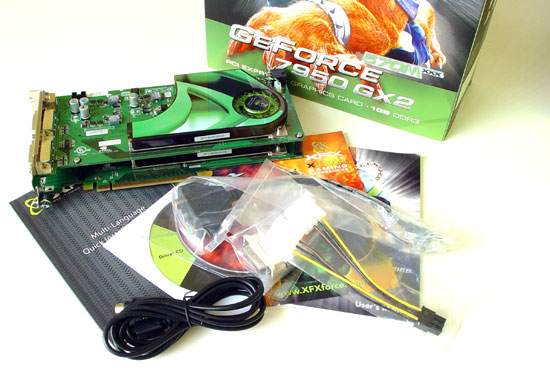Page 3
The GeForce 7950 GX2 from XFX
Next to the reference model of the GeForce 7950 GX2 we'll be testing today we'll also team up an "XXX" edition of this card (from XFX) into this review.
The XXX Edition of the GeForce 7950 GX2 means you receive a card preoverclocked by default, so there's no need for you to overclock manually. Two huge benefits come from this, the first being your overclocking is covered by warranty. Secondly, these cards have been pre-tested by XFX to see if they actually can take a high overclock, something which is always a bit of a gamble with a regular card. The downside is you pay premium price for a little extra operformance.
Here's a thought. Since we know XFX is testing these cards manually, the "regular" versions likely will not overlock as well as they did not pass the Extreme Edition or XXX qualification. So what's overclocked then? Basically two things. First being the graphics core as it's running at a sweet 570 MHz (500 on reference design). The second important factor is obviously the framebuffer, a.k.a. memory, which normally runs at 2x600 MHz and now is running at 2x775 MHz. Not bad eh?
Today's tested GeForce 7950 GX2 with 1024MB gDDR3 memory is available as we speak and actually in pretty good volumes, keeping the prices level where they should be. Today's product will carry a MSRP of 699 USD and with that price we are finally back at an unfortunately too high price level.
You're at Guru3D.com, we're going to make this card sweat as we launch our entire benchmark suite at this graphics card to monitor its performance at several image quality settings. Of course you'll see the usual technology overview, photoshoot, overclocking experiences and finally my verdict.
What's inside the XFX bundle?
The software bundle is really okay as a full game was included. Tomb Raider Legends, now that's good value! Furthermore you'll find:
- Driver CD with a set of tools
- S-Video Cable
- DVI to VGA Adaptor
There's nothing much to be said here other than it's a nice bundle and has everything included to get you going for sure. The card itself evidently is 100% NVIDIA reference based, except for a little XFX sticker and the pre-mod overclock which has been locked in the BIOS. That "XXX" clock of the card we can translate to a 570 MHz core clock (500 default) and 1800 MHz memory clock (1700 default). And that's quite something as you'll get even more screamingly fast performance right out of the box.

What is a shader ? What do we need to render a three dimensional object; 2D on your monitor? We start off by building some sort of structure that has a surface, that surface is being built from triangles and why triangles? They are quick to calculate. How's each triangle being processed? Each triangle has to be transformed according to its relative position and orientation to the viewer. Each of the three vertices the triangle is made up of is transformed to its proper view space position. The next step is to light the triangle by taking the transformed vertices and applying a lighting calculation for every light defined in the scene. At last the triangle needs to be projected to the screen in order to rasterize it. During rasterization the triangle will be shaded and textured.
